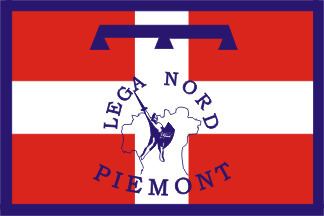Secretary Riccardo Molinari Founded April 1987 National affiliation Lega Nord | President Stefano Allasia Ideology Federalism
Regionalism Regional Council of Piedmont 2 / 50 | |
 | ||
Lega Nord Piemont (English: Piedmont Northern League, LNP) is a regionalist political party in Italy active in Piedmont, Italy. It is the "national" (hence, regional) section of Lega Nord in the region.
Contents
- Early years
- Splits and recovery
- Cota President of Piedmont
- From Cota to Molinari
- Popular support
- Leadership
- References
Riccardo Molinari serves as the party's national secretary, while Stefano Allasia is its president.
Roberto Cota, who led the party from 2001 to 2016, was President of Piedmont from 2010 to 2014.
Early years
The party was founded in April 1987 by spliters from Piedmontese Union (Union Piemontèisa, UP) led by Gipo Farassino and Mario Borghezio. This group, which took the name of Piedmontese Autonomist Movement (Moviment Autonomista Piemontèis, MAP) and later Autonomist Piedmont (Piemont Autonomista, PA), wanted to make an alliance with Lega Lombarda of Umberto Bossi, in contrast with UP leader Roberto Gremmo.
PA participated in the 1989 European Parliament election as part of the coalition Lega Lombarda – Alleanza Nord. In 1989–1990 it took part to the process of integration of the Northern regionalist parties, ahead of regional elections, and, finally, in February 1991, it was merged into Lega Nord, taking the current name.
In 1994 Farassino fended off a challenge by Oreste Rossi and was narrowly re-elected national secretary.
In the 1996 general election the party obtained its highest and still unparallaled result: 18.2%.
In 1997 Farassino was replaced as secretary by Domenico Comino.
Splits and recovery
In 1999 the party suffered a damaging split when Comino left the party over disagreements with Umberto Bossi, federal secretary of Lega Nord, and started his own party, which was integrated into the Autonomists for Europe (ApE) in 2000.
Troubled by splits and a huge loss of popular support (the party was reduced from 18.2% to 7.8% in just three years), LNP entered into the centre-right House of Freedoms coalition. From 2000 to 2005 the party took part to the regional government led by Enzo Ghigo (Forza Italia), which included LNP long-time leader Gipo Farassino as regional minister of Culture, while Roberto Cota was appointed President of the Regional Council.
In 2001 Cota was elected national secretary of LNP with the mandate of re-building the party.
Between 2006 and 2008 the party doubled its share of vote from 6.3% to 12.3%. Subsequently, Cota became floor leader of Lega Nord in the Chamber of Deputies.
In the 2009 European Parliament election LNP increased again its share reaching 15.7%, its best electoral result since 1996.
Cota President of Piedmont
In the run-up of the 2010 regional election, Cota was chosen as joint candidate for President by The People of Freedom (PdL) and Lega Nord.
The day after his bid was announced, Cota explained that it was time to rewrite the history of Italian unification, that was led by the Kingdom of Sardinia under the House of Savoy. Cota underlined that Piedmont was to be once again an independent state and claimed that even Camillo Benso, Count of Cavour, Italy's first Prime Minister, did not intend to unify the whole Italian Peninsula and, later, favoured a federal reform of the new Kingdom of Italy. For these reasons Cota, a republican with no nostalgia for the House of Savoy, said that his message would do well in Piedmont and that he would overcome the weakness of LNP (which usually gets far less votes than Liga Veneta in Veneto and Lega Lombarda in Lombardy). In Cota's view, most of his support would come from industrial workers, including those of Southern Italian descent, and Catholics embarrassed by the incumbent President Mercedes Bresso's secularism.
In March Cota was narrowly elected President (he took 47.3% of the vote against Bresso's 46.9%) and LNP tripled the number of its seats in the Regional Council from four to twelve. Instrumental for Cota's victory were the strong showing of Beppe Grillo's Five Star Movement, which gained 3.7% of the vote mainly from centre-left voters, and the Catholic vote that tilted to Cota, disappointing the Union of the Centre, allied with Bresso in the election.
Cota was forced to resign in early 2014, due to irregularities committed in 2010 by one of its supporting lists in filing the slates for the regional election, and chose not to stand again. In the 2010 regional election Democrat Sergio Chiamparino was elected President of Piedmont and LNP was reduced to a mere 7.3% of the vote.
From Cota to Molinari
In February 2016, during a hard-fought national congress, Riccardo Molinari replaced Cota as national secretary. Molinari, who was supported by the new Lega Nord federal secretary Matteo Salvini, obtained 446 votes (55.1%) from delegates, while his opponent Gianna Gancia, the incumbent national president chiefly supported by Gianluca Buonanno MEP and her husband and party heavyweight Roberto Calderoli, 364 votes (44.9%). Subsequently, Stefano Allasia was elected president.
Popular support
The party has its stongholds in the outer provinces, in rural and in mountain areas of Piedmont. In the 2010 regional election it won 25.3% in Cuneo, 24.4% in Vercelli, 21.6% in Verbano-Cusio-Ossola, 21.1% in Novara, 20.6% in Asti and 20.2% in Biella.
The electoral results of Lega Nord Piemont in the Region are shown in the table below.
